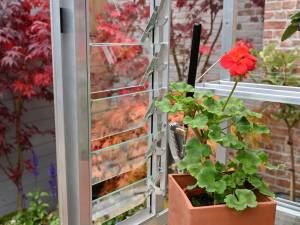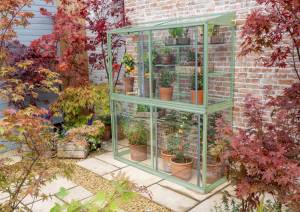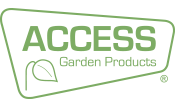What is the best position for a greenhouse?

If you are asking ‘What is the best position for a greenhouse?’ then choosing the optimal position for your greenhouse is a critical decision that can significantly impact the success of your gardening endeavours. However, while there may be a ‘best’ location, even if the location of the greenhouse is not ideal, it will still allow so much more in the garden to be grown and protected compared to not having a greenhouse at all.
We often speak to customers who say “I would love a greenhouse, but I have nowhere to put it”; but with our mini greenhouses we have a wide range of models which will fit into even the tiniest spaces. Ideally you will want some sunlight in the location, even if it is only for part of the day, but if there is no direct sunlight but good general light, you can still make use of the space.
Considerations for the best greenhouse position

If there are a number of locations available in the garden, then there are various factors to consider when choosing the best spot, including sunlight exposure, wind protection, and space constraints. In this comprehensive guide, we’ll explore the advantages and disadvantages of different greenhouse orientations, including East, West, South, and North-facing greenhouse positions. Additionally, we’ll compare the pros and cons of freestanding greenhouses versus lean-to structures and discuss solutions for tricky locations such as shaded areas or small plots, including miniature greenhouses.
East-Facing Greenhouses
Generally East facing is one of the best aspects for a greenhouse as it occupies the ‘Goldilocks’ location of not too hot and not too cold. The greenhouse will have the sun in the morning, warming up the greenhouse for the rest of the day.
If the greenhouse is East facing, then some form of automatic ventilation is needed as in the UK the sun will rise around 5am in the late Spring – much earlier than most people get up.
Advantages:
- For greenhouses the adage is ‘East or West is best’
- Receives morning sunlight, providing gentle warmth and promoting early growth.
- Protection from intense afternoon sun, reducing the risk of overheating.
- Ideal for plants that prefer cooler temperatures or are sensitive to excessive heat.
Disadvantages:
- Limited sunlight exposure in the afternoon and evening, which may affect growth and fruiting of some Mediterranean crops.
- Potential for cooler temperatures during the day, especially in winter months.
- Again, an ideal position for the greenhouse, taking advantage of the longer evenings. For Chillies and Peppers, which need as much warmth as possible, West is marginally better than East.
West-Facing Greenhouses
Advantages:
- Along with East facing, considered to be the best orientation.
- Receives afternoon and evening sunlight, maximizing light exposure for plants during peak growing hours.
- Warmer temperatures in the afternoon, which can be beneficial for heat-loving crops.
- Extended daylight hours in the summer, allowing for longer growing seasons.
Disadvantages:
- Increased risk of overheating, particularly in the summer months.
- Potential for cooler temperatures in the morning, which may delay plant growth.
South-Facing Greenhouses
Often seen as the best location for the greenhouse, this aspect will generate the most warmth and will be exposed to the most sunlight during the year. Traditionally in Victorian kitchen gardens, the greenhouse was always sited on the south facing wall. However, unless you have a team of gardeners assiduously ventilating and watering the plants, the heat generated on a southern location can be ‘too much of a good thing’.

Advantages:
- Maximum sunlight exposure throughout the day, providing optimal growing conditions for a wide range of crops.
- Warmer temperatures and higher light intensity, promoting robust growth and fruiting.
- Ideal for year-round gardening, with ample sunlight even in the winter months.
Disadvantages:
- Potential for heat stress in sensitive plants, especially during heatwaves.
- Plants can dry out very quickly, resulting in water stress and disease.
North-Facing Greenhouses
People often perceive a north facing aspect to be a death-knell for a greenhouse, but in fact there is plenty that can be grown on a north facing location. Always choose a north facing greenhouse over no greenhouse at all, as it will still provide a great boost to the garden.
You won’t be able to grow Chillies, Peppers or Cucumbers, but the even light is ideal for seedings and more delicate plants, especially later in the season where seedlings on a southern aspect would be burnt to a shrivel.
To really make the most of the greenhouse you could add an LED grow light – make sure you get a waterproof light if you are using a greenhouse watering system. You can also add a heater to prevent frost, as a north facing greenhouse will always be cooler.
Advantages:
- More consistent temperatures and reduced risk of overheating, making it suitable for cool-season crops.
- Less direct sunlight exposure, which may be beneficial for shade-loving plants or those sensitive to intense light.
- Ideal for seedlings and young plants being grown later in the season.
Disadvantages:
- Limited sunlight exposure, especially in the winter months, which may affect plant growth and productivity.
- Cooler temperatures and shorter daylight hours, requiring supplemental heating and lighting in colder climates.
Freestanding vs Lean-To Greenhouses
Each type of greenhouse has their advantages and disadvantages – the wall on the lean-to absorbs heat, making it much warmer and reducing any heating requirements, while a free-standing model allows more light into the greenhouse and allows more flexibility for siting the greenhouse as a suitable wall is not needed.
One of each is a great solution, with a larger free-standing greenhouse further away down the garden and then a smaller lean-to near the house for starting off plants in the early spring and for herbs for the kitchen.
Freestanding Greenhouses
The vast majority of greenhouses sold in the UK are free-standing models that are sited in the garden, further away from the house.
Advantages:
- Flexibility in positioning, allowing for optimal sunlight exposure and airflow.
- Can be placed anywhere in the garden, maximising available space and landscaping options.
Disadvantages:
- Requires more space compared to lean-to structures, which may be a constraint in smaller gardens.
- More susceptible to wind damage, requiring additional anchoring and structural support.
Lean-To Greenhouses
Lean-to greenhouses will often utilise a house wall, saving costs as there is no back and also providing a growing space close to the house – ideal for keeping an eye on plants and for growing herbs and salads.
Advantages:

- Utilises an existing structure, such as a wall or building, for support and insulation.
- Saves space and maximises available sunlight, making it ideal for smaller gardens or limited outdoor areas.
- Will be warmed by the sun before most people get up, so automatic ventilation is recommended.
- Warmer than a free-standing greenhouse, reducing the danger of frost damage and any heating costs.
Disadvantages:
- Limited flexibility in positioning, as it must be attached to a suitable structure.
- May receive less sunlight compared to freestanding greenhouses, depending on the orientation of the supporting wall.
Tricky Locations and Miniature Greenhouses
For gardeners facing challenges such as shaded areas or very small plots, miniature greenhouses offer a viable solution. These compact structures provide a controlled environment for growing plants, allowing for year-round gardening in challenging spaces. With options ranging from table top models to small walk-in designs, miniature greenhouses are versatile and adaptable to various garden layouts and constraints.
Conclusions
So, in answering the question ‘What is the best position for a greenhouse?’, we have seen that all aspects have their own unique characteristics and like all gardening, it is a question of playing to the individual characteristics of the garden in question. Even if you don’t consider your site to be ideal, rest assured that even the trickiest aspects will provide great benefits and Access GArden Products are able to provide a wide range of different models to suit almost every garden.
